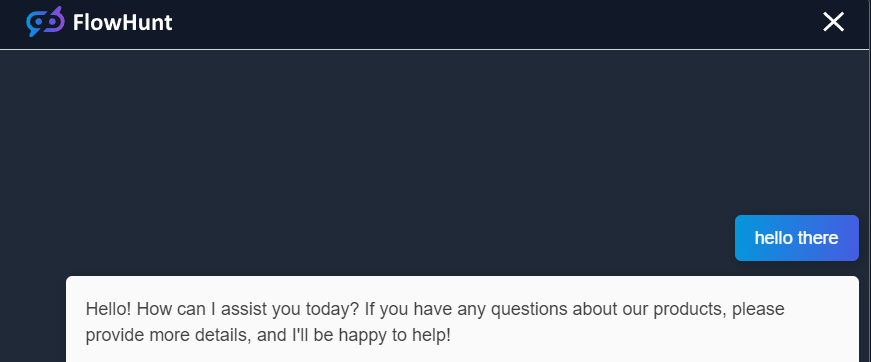
The Future Is Prompted: Why Prompt Engineering Is the New Core Skill?
Discover why prompt engineering is rapidly becoming an essential skill for every professional, how it’s transforming workplace productivity, and ways to start m...

Discover prompt engineering strategies to enhance the accuracy, consistency, and performance of Ecommerce chatbots using FlowHunt’s AI tools.
Prompt engineering involves crafting precise instructions that guide AI language models in generating the desired outputs. It is a critical practice that helps the chatbot understand and respond appropriately to various queries. Effective prompt engineering can transform a chatbot into a reliable and user-friendly assistant.
Well-crafted prompts help the AI better comprehend user queries, resulting in more accurate and relevant responses. This is essential for maintaining high-quality interactions and meeting customer expectations.
Structured prompts ensure that the chatbot delivers consistent performance, regardless of the context or nature of the interaction. This consistency is crucial for building trust and reliability.
By providing clear and relevant responses, effective prompt engineering enhances user satisfaction. A chatbot that understands and addresses user needs promptly improves the overall customer experience.
Effective prompts reduce the need for additional follow-up questions, streamlining interactions and saving time for both users and the chatbot. This efficiency contributes to a smoother and more satisfying user experience.
Delimiters, such as “””, < >, or <tag> </tag>, help separate each part of the input, enabling the chatbot to understand and process different parts of the query efficiently. For example:
You are a customer service specialist. Your task is to answer queries from {input} using resources.
---CUSTOMER'S QUERY---
{input}
ANSWER:
This format ensures that the chatbot knows where the query starts and ends, providing a clear structure for its response.
Structured outputs guide the chatbot through a step-by-step process, improving the quality of its responses. For example:
This method helps the chatbot “think” and provide comprehensive answers.
Challenge: Sometimes, the AI would generate gibberish to a simple greeting because it wasn’t told to generate a friendly response like a human would, and instead found random products to talk about.
Solution: Add a simple line like this before the output:
If no relevant context is available, try to look for the information on the URLs. If there is no relevant information, then refrain from generating further output and acknowledge the customer’s inquiry or greet them politely.
This way, the chatbot generates appropriate answers to greetings.

Structuring the prompt to include initiation steps helps the chatbot know how to start its task. Here’s an enhanced version:
Your task is to analyze and provide feedback on product details using the context. Evaluate the product information provided, give structured and detailed feedback to customers, and identify relevant products based on the provided context.
CONTEXT START
{context}
CONTEXT END
INPUT START
{input}
INPUT END
task if the user asks for specific products or product comparison:
1. **Overview:** A brief description of the product or information using the metadata provided.
2. **Key Features:** Highlight the key features of the product or information.
3. **Relevance:** Identify and list any other relevant products or information based on the given metadata.
START OUTPUT
END OUTPUT
If no relevant context is available, try to look for the information on the URLs. If there is no relevant information, then refrain from generating further output and acknowledge the customer's inquiry or greet them politely.
ANSWER:
This structure ensures the chatbot can handle different types of queries and provide relevant responses.
Currently, the LLM has issues with translation and answers exclusively in English. To address this, add at the beginning of the prompt:
(It is important to translate to the relevant language)
This addition helps combat translation issues in chatbot responses.
Combining all the tactics, the final prompt structure is as follows:
Your task is to analyze and provide feedback on product details using the context but it is important to translate to the relevant language. Evaluate the product information provided, give structured and detailed feedback to customers, and identify relevant products based on the provided context.CONTEXT START
{context}
CONTEXT ENDINPUT START
{input}
INPUT END
task if the user asks for specific products or product comparison:
1. **Overview:** A brief description of the product or information using the metadata provided.
2. **Key Features:** Highlight the key features of the product or information.
3. **Relevance:** Identify and list any other relevant products or information based on the given metadata.START OUTPUT
END OUTPUT
If no relevant context is available, try to look for the information on the URLs. If there is no relevant information, then refrain from generating further output and acknowledge the customer's inquiry or greet them politely.
If user's not satisfied, use {chat_history}
ANSWER:
Ensuring that prompts are clear and specific is vital. Ambiguity can lead to misunderstandings and incorrect responses. For instance, a prompt like:
“Provide the key features and benefits of this product”
yields more detailed and useful responses than a vague query like:
“Tell me about this product.”
Incorporate relevant context into the prompts to help the chatbot understand the background of the query. For example:
CONTEXT START
Product: XYZ Phone
Features: 64GB Storage, 12MP Camera, 3000mAh Battery
Price: $299
CONTEXT END
This contextual information guides the chatbot to generate more relevant and accurate answers.
Continuous testing and refinement of prompts are essential. Regularly updating and optimizing prompts based on user feedback ensures that the chatbot remains effective and relevant.
Understanding user intent is crucial. Designing prompts that capture and respond to the user’s underlying needs can significantly enhance the chatbot’s usefulness.
Few-shot learning involves providing the AI model with a few examples of the desired output alongside the prompt. For example:
Example 1:
User: How long does shipping take?
Bot: Shipping typically takes 5-7 business days.
Example 2:
User: What is the return policy?
Bot: You can return products within 30 days of purchase for a full refund.
Your turn:
User: {input}
Bot:
Zero-shot learning involves designing prompts in a way that the model can generate accurate responses without any prior examples. This requires crafting highly specific and detailed prompts. For instance:
You are an expert in customer service. Provide detailed information about the company's warranty policy when asked by a customer.
Prompt engineering involves crafting precise instructions that guide AI language models in generating desired outputs, helping chatbots understand and respond accurately to customer queries.
Effective prompt engineering improves chatbot accuracy, consistency, and user satisfaction by ensuring clear, relevant, and structured responses to various customer inquiries.
Key tactics include using delimiters to separate input parts, asking for structured outputs, providing context, addressing translation issues, and refining prompts based on feedback.
Few-shot learning provides the model with a few examples to guide responses, while zero-shot learning designs prompts so the model can respond accurately without prior examples.
Yasha is a talented software developer specializing in Python, Java, and machine learning. Yasha writes technical articles on AI, prompt engineering, and chatbot development.

Smart Chatbots and AI tools under one roof. Connect intuitive blocks to turn your ideas into automated Flows.

Discover why prompt engineering is rapidly becoming an essential skill for every professional, how it’s transforming workplace productivity, and ways to start m...

Prompt engineering is the practice of designing and refining inputs for generative AI models to produce optimal outputs. This involves crafting precise and effe...

Master AI chatbot prompts with our comprehensive guide. Learn the CARE framework, prompt engineering techniques, and best practices to get better AI responses. ...
Cookie Consent
We use cookies to enhance your browsing experience and analyze our traffic. See our privacy policy.